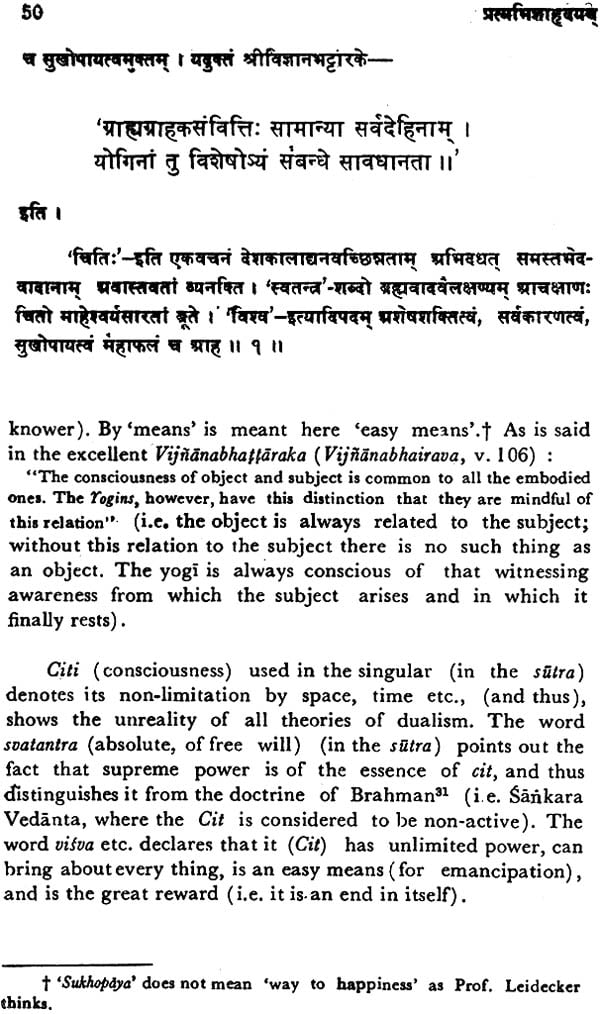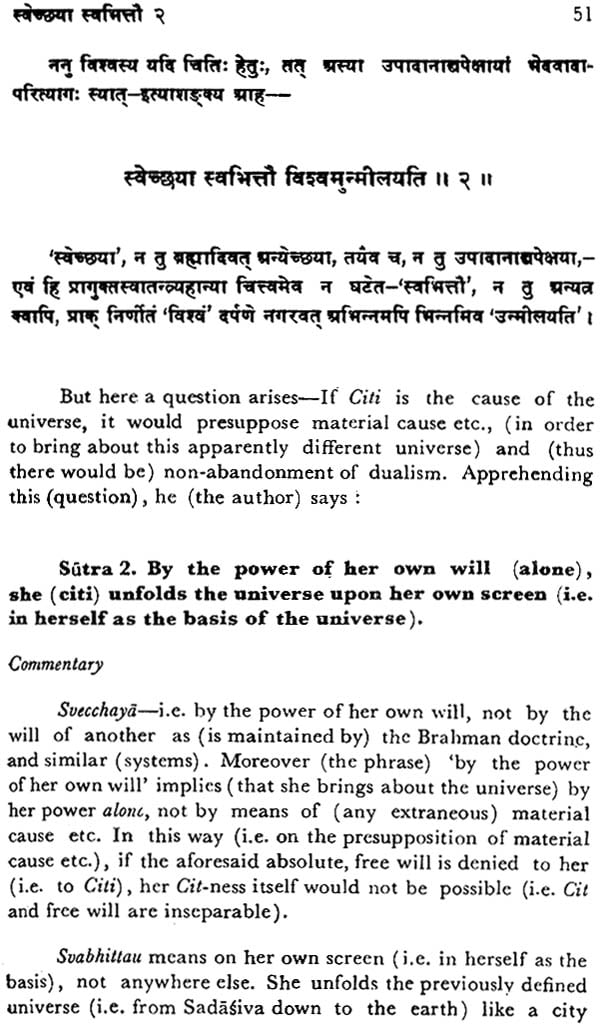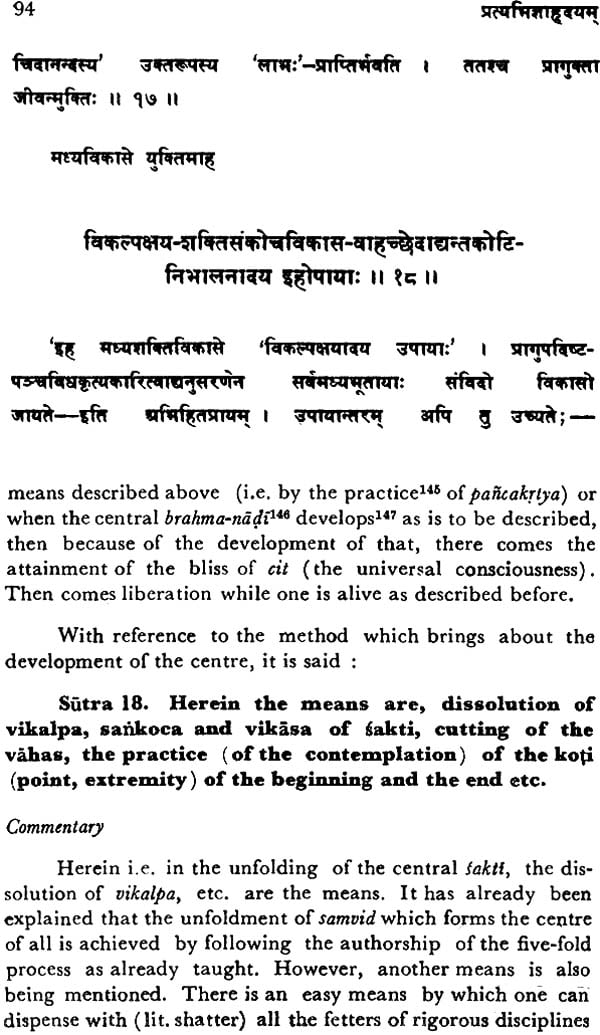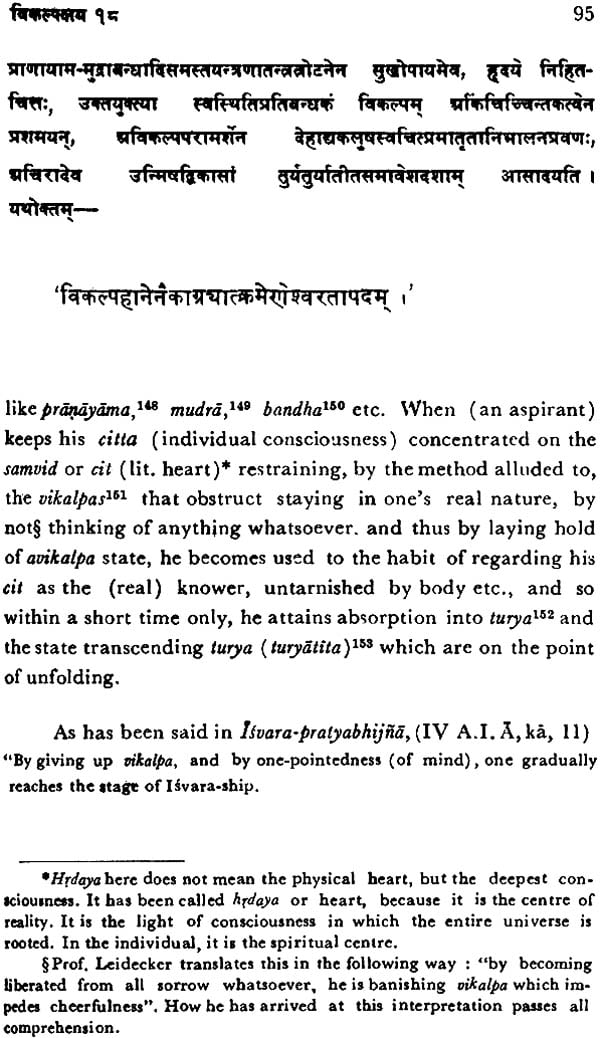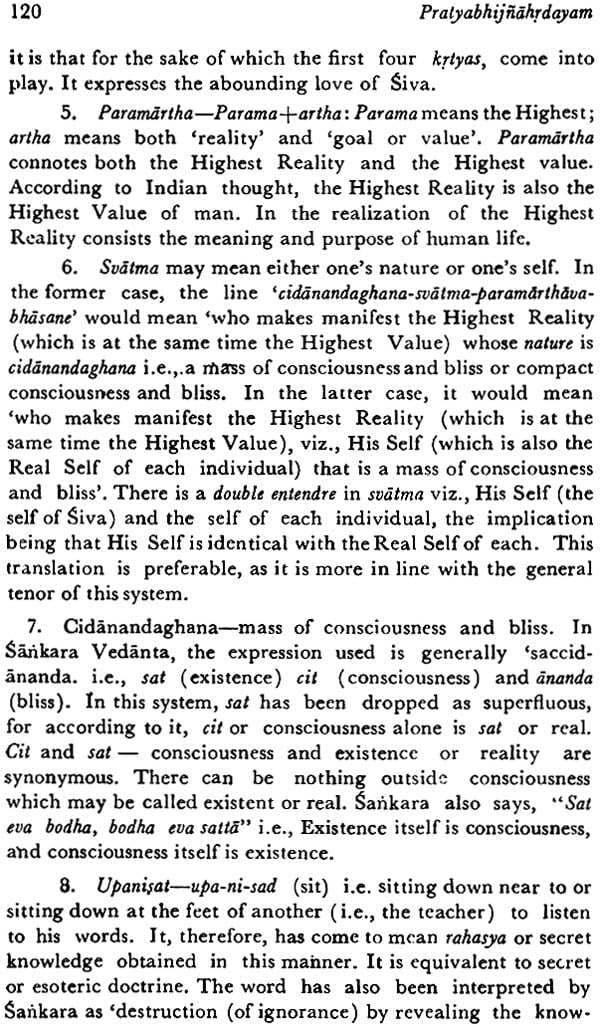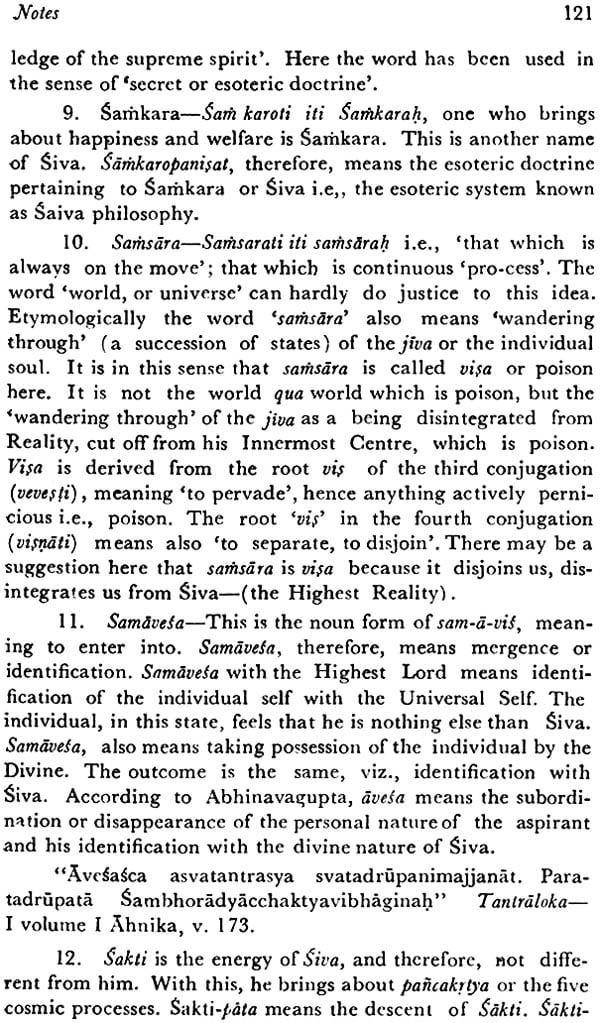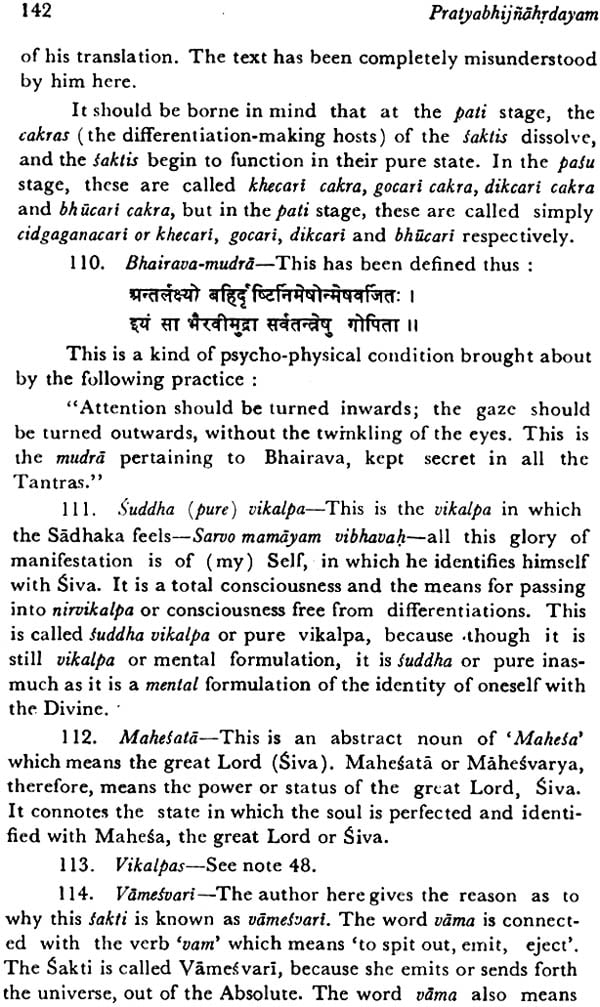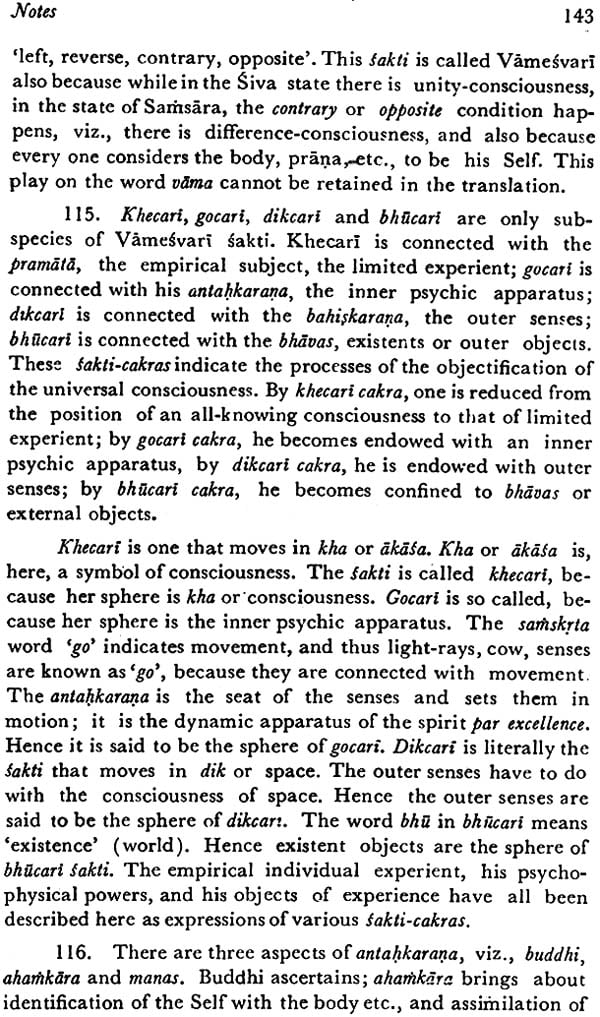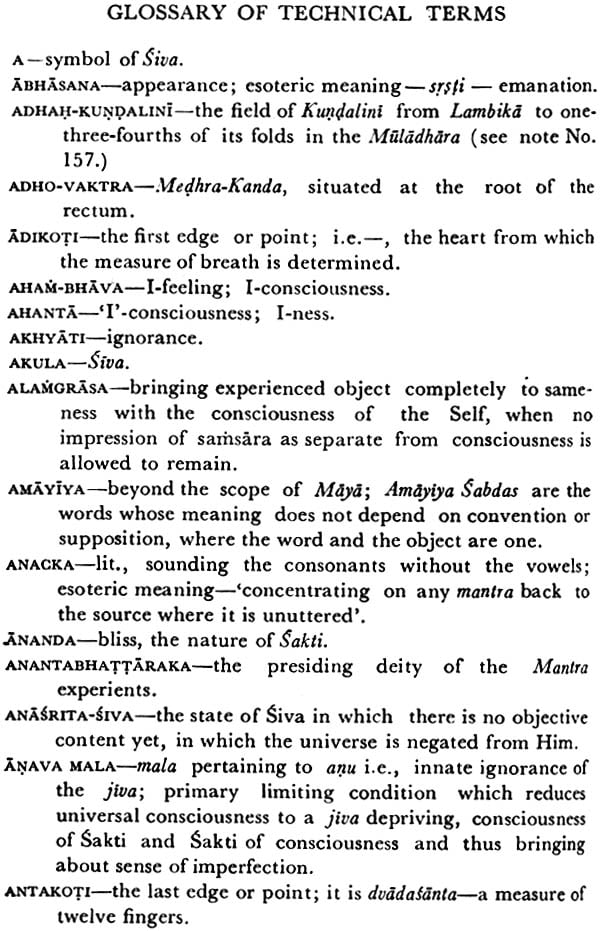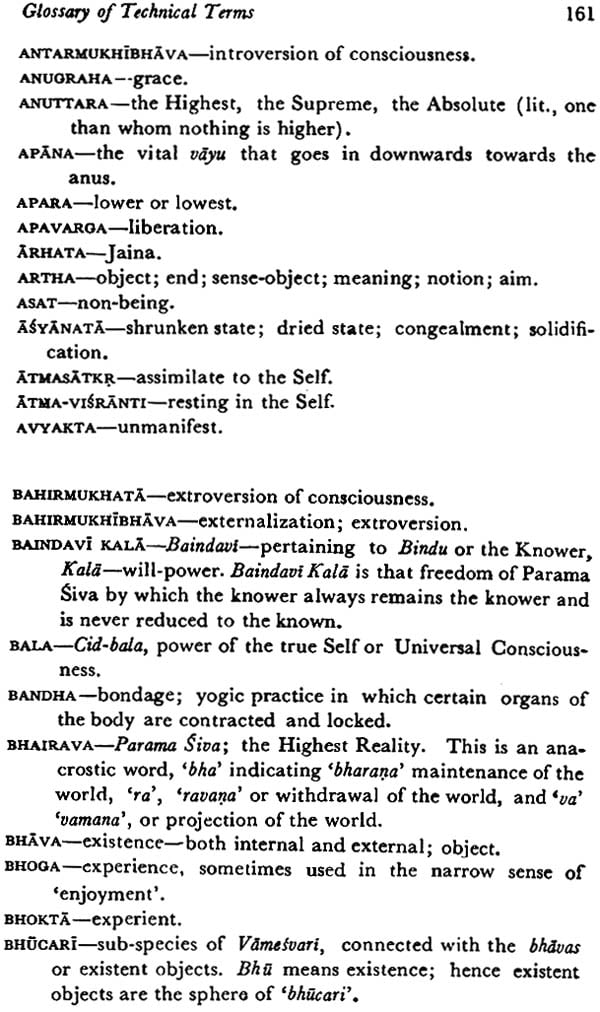
Pratyabhijnahrdayam (The Secret of Self-Recognition)
Book Specification
| Item Code: | IDD578 |
| Author: | Jaideva Singh |
| Publisher: | MOTILAL BANARSIDASS PUBLISHERS PVT. LTD. |
| Language: | English |
| Edition: | 2016 |
| ISBN: | 9788120803237 |
| Pages: | 197 |
| Cover: | Paperback |
| Other Details | 8.5 inch X 5.5 inch |
| Weight | 290 gm |
Book Description
This little work is digest of the Pratyabhijna system of Kashmir Saiva Philosophy, prepared by Ksemaraja, the illustrious disciple of Abhinavagupta. It avoids all polemics and gives in a very succinct form (20 sutras) and main tenets of the Pratyabhijna presented by Utpala. Pratyabhijna means recognition. Jiva is Siva; by identifying himself with his body. Jiva has forgotten his real nature. This teaching is meant to enable Jiva to recognise his own real self i.e., Siva and to suggest to him the spiritual discipline needed to attain 'at-one-ment' with SIVA.
Dr. Jaideva Singh has considerably revised and enlarged his translation, and provided a scholarly Introduction, Notes, Glossary of technical terms and Indexes. It serves as the best introduction to Pratyabihjna philosophy.
The Paratrigika (or Parathrnika) is a short Tantra which has been held in the highest esteem by Kashmir Saivism or Trika. After Somananda, Abhinavagupta has written two commentaries on it, a short one (Laghuvrtti) and an extensive one— the present Vivarana which is presented here for the first time in an English translation. The Parãtrisika Vivaraziais one of the most fascinating but also most difficult texts of the Kashrnir Saiva School, and of the mystical philosophical literature of India as a whole. It deals with Ultimate Reality (anuttara or para) and with the methods of realization, centered above all in the theory and practice of the mantra. Abhinavagupta displays here his great exegetical genius and presents a penetrating metaphysics of language, of the Word (yak) and its various stages in relation to consciousness His language reflects in a luminous fashion the mystical experience contained in this text.
The present translation of Abhinavagupta’s masterpiece will not only be a milestone in the study of Kashmir Saivism, but it also makes available one of the major mystical texts of the Indian tradition to readers interested in philosophy and spirituality.
Jaideva Singh (1893-1986) was a great scholar in musicology, philosophy and Sanskrit. A former principal of Y.D. College Lakhimpurkheri he also acted as a chairman of U.P Sangit natak Academi. He was awarded Padma Bhushan by the Government of India in 1974. His other works include Siva Sutras Spanda Karika Pratyabhijnahrdayam, Vijanabhairava.
In this edition misprints occurring in the previous edition have been corrected.
Alteration in the text of the translation has been made at a few places for the sake of greater clarity.
The notes have been improved upon at a few places.
In this edition both the introduction and notes have been considerably enlarged.
In the introduction three new topics viz, svatamtryavada and Abhasavada Sadadhva and comparison and contrast with Samkara’s Advatiavada have been added. Considerable new additions have been made in the notes.
At some places alteration has been made in the translation of the text for the sake of greater clarity.
With these additions and alterations the book has been greatly improved and will it is hoped be of considerable value to the readers.
In this edition a few misprints that had crept in have been corrected.
Alteration in the translation of the text has been made at two or three places for the sake of greater clarity.
The whole book has been thoroughly revised.
Pratyabhjinahrdayam serves as the best introduction to the Pratyabhijna philosophy of Kashmir. An English translation of the book by Prof. K.F. Leidecker is already available. My only apology for bringing out another translation of the book is that the one that is available bristles with mistakes, some of which are quite serious. It has been my painful duty to point out a few of the serious mistakes. No one who has not studied this book with a teacher can work away its translation merely with the assistance of a lexicon and grammar. I had the good fortune of studying it with Swami Lakshman Joo who is practically the sole surviving exponent of this system in Kashmir, and who not only embodies within himself the tradition of the school, but has also practiced the yogic disciplines recommended by it. He has helped me not only by explaining the technical words but also in tracing out the sources of most of the quotations occurring in the book. I am deeply grateful to him for his kind help.
The Sanskrit text adopted is that of the Kashmir Sanskrit Series. The translation is given below each page of the text. It closely follows the original—with a few words here and there in parenthesis to make the sense clearer. A person knowing even a little of Sanskrit can follow the translation almost word for word. I have tried to make the translation as flawless as possible. Some of the highly technical terms have been used in it as they occur in the original, but their connotation has been elaborately elucidated in the notes.
An introduction containing the chief features of the Pratyabhijña system has been provided. An analysis of the contents of each Sutra has also been given. Copious notes on difficult and technical words have been added, and a glossary of the technical terms has also been appended at the end.
While the book was at the proof stage, I referred my difficulties in some of the Sutras to MM. Dr. Gopinath Kaviraja and profited greatly by his illuminating expositions. I have used his suggestions with advantage in some of my notes. I am deeply grateful to him for his kind help. Acharya Pandit Rameshwar Jha was helpful in the clarification of some difficult passages of the text I therefore offer him my heart felt thanks.
The Saiva religion is perhaps the most ancient faith of the world. Sir John Marshall says in his Mohenjodaro and the Indus Civilization that excavations in Mohenjodaro and Harappa reveal an important fact, viz., that Sivaism has a history going back to the Chalcolithic Age further still, and that it thus takes its place ancient living faith in the world. It had many off-shoots and appeared in different forms in many parts of the world. Jn India, there are three main forms of this religio-philosophy, viz., the Vira-Saiva form in Deccan-Karnâtaka, the SaivasiddhAnta in Tamila Nã4u, and the Advaita Saiva form in Kashmir. There are some common features in all the three, but there are important differences also. Here we concerned with the AdvaitaSaiva Philosophy of Kashmir.
In India, there is no such thing as arm-chair philosophy. Philosophy is not only a way of thought, but also a way of life in this country. It is not born of idle curiosity, nor is it a mere intellectual game. Every philosophy here is a religion, and every religion has its philosophy. The philosopher here was not a tall and spectacled professor dictating his notes to the class or weaving cob-webs of theory in his study, but one who was moved by a deep inner urge to know the secrets of life, who lived laborious days of spiritual discipline and who saw the light by the transformation of his life. Moved by pity for his fellow-men, he tried to interpret the truth he had experienced to the logical reason of man. Thus arose philosophy in this country.
The Advaita Saiva Philosophy of Kashmir was of this type. For centuries, it was imparted as a secret doctrine to the aspirant who had to live it and test it in the laboratory of the Self. In course of time only the cult and the ritual remained; the philosophical background was forgotten. Perhaps, a select few still knew the philosophical doctrine by oral tradition but the first thinker known to history who reduced the main principles to writing was Vasugupta. He is said to have lived towards the end of the eighth or the beginning of the ninth century A.D. Since then philosophical writing had been active and continued process in Kashmir which went on for nearly four centuries. The literature on this system has accumulated to such an extent that it would require almost a life time to study it. Some works of the system have still not been published.
| Preface to the Fourth Edition | vii |
| Preface to the Second Edition | viii |
| Preface to the Third Edition | viii |
| Preface to the First Edition | ix |
| I. Introduction | 1 |
| II. Analysis of Contents | 34 |
| III. Sanskrit Text with English translation | 45 |
| Notes | 117 |
| Glossary of technical terms | 160 |
| Sanskrit Index | 173 |
| English Index | 182 |
